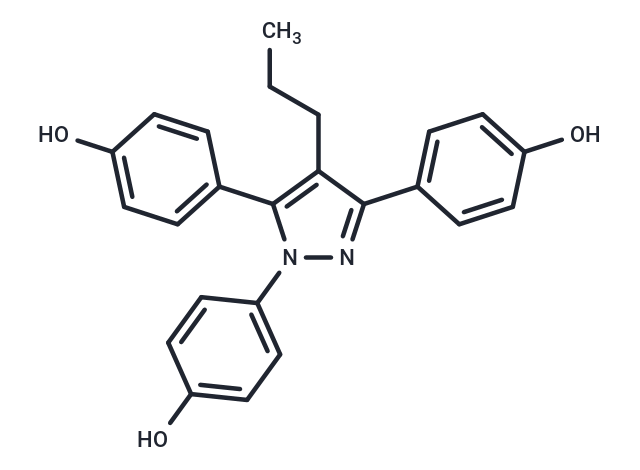Shopping Cart
- Remove All
 Your shopping cart is currently empty
Your shopping cart is currently empty

Propyl pyrazole triol (PPT) is a selective agonist of estrogen receptor alpha (ERα), exhibiting a relative binding affinity of 49% for ERα, which is approximately 410 times higher than its affinity for estrogen receptor beta (ERβ: 0.12%).

| Pack Size | Price | Availability | Quantity |
|---|---|---|---|
| 1 mg | $38 | In Stock | |
| 5 mg | $89 | In Stock | |
| 10 mg | $143 | In Stock | |
| 25 mg | $279 | In Stock | |
| 50 mg | $443 | In Stock | |
| 100 mg | $663 | In Stock | |
| 200 mg | $928 | In Stock | |
| 1 mL x 10 mM (in DMSO) | $97 | In Stock |
| Description | Propyl pyrazole triol (PPT) is a selective agonist of estrogen receptor alpha (ERα), exhibiting a relative binding affinity of 49% for ERα, which is approximately 410 times higher than its affinity for estrogen receptor beta (ERβ: 0.12%). |
| Targets&IC50 | ERα:140 pM(EC50) |
| In vitro | In ERα-U2OS-Luc cells, the EC50 of Propyl pyrazole triol for the ERα-dependent response is 140 pM[1]. |
| Alias | PPT |
| Molecular Weight | 386.44 |
| Formula | C24H22N2O3 |
| Cas No. | 263717-53-9 |
| Smiles | CCCc1c(nn(c1-c1ccc(O)cc1)-c1ccc(O)cc1)-c1ccc(O)cc1 |
| Relative Density. | 1.31g/cm3 |
| Storage | Powder: -20°C for 3 years | In solvent: -80°C for 1 year | Shipping with blue ice. | |||||||||||||||||||||||||||||||||||
| Solubility Information | DMSO: 99 mg/mL (256.18 mM), Sonication is recommended. | |||||||||||||||||||||||||||||||||||
Solution Preparation Table | ||||||||||||||||||||||||||||||||||||
DMSO
| ||||||||||||||||||||||||||||||||||||

Copyright © 2015-2025 TargetMol Chemicals Inc. All Rights Reserved.